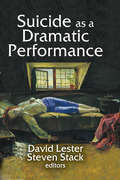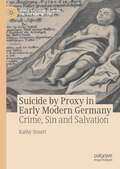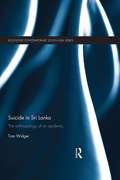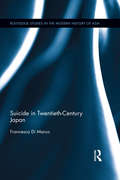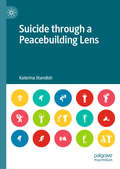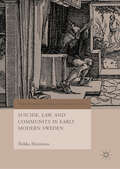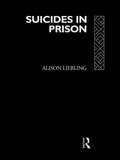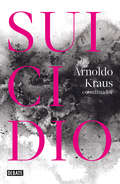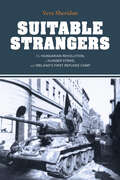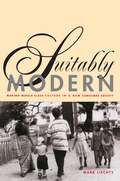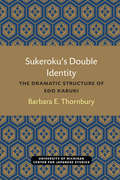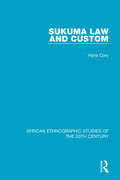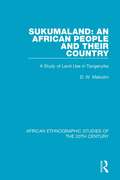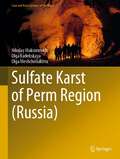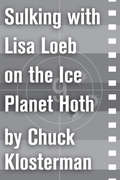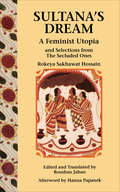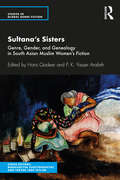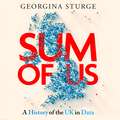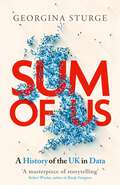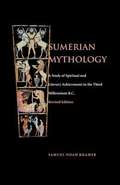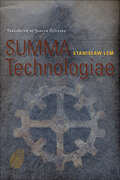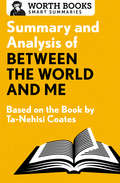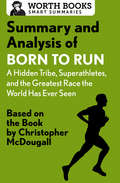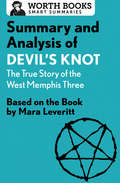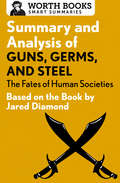- Table View
- List View
Suicide as a Dramatic Performance
by David LesterEach suicide is as unique as the individuals involved, especially if one examines the nature of the act and to what extent these acts can be viewed as a theatrical performance. Focusing on the dramatic aspects of suicide may seem tangential to the physical and mental pain experienced by those who try to kill themselves, but dramatic aspects often provide important clues for understanding the mental state of suicidal individuals.David Lester and Steven Stack investigate what happens in the weeks, days and hours before a suicide when the suicidal individual must make decisions and formulate the script for his or her suicidal act. The editors argue that these choices may help us understand and prevent other suicides and stimulate new and innovative research in this important area.Through twenty-five substantive chapters, including both quantitative and qualitative analyses, this book offers insights into suicide as a dramatic act, with chapters on the intended audience, the suicide note, the location and method chosen, and cultural scripts, including suicide-by-cop, sati, seppuku, and duels. The contributors to this volume argue that psychological, social, and cultural factors influence these choices and that the decisions made by the individual are important for understanding the mental state of the person choosing to die by suicide.
Suicide by Proxy in Early Modern Germany: Crime, Sin and Salvation (World Histories of Crime, Culture and Violence)
by Kathy StuartSuicide by Proxy became a major societal problem after 1650. Suicidal people committed capital crimes with the explicit goal of “earning” their executions, as a short-cut to their salvation. Desiring to die repentantly at the hands of divinely-instituted government, perpetrators hoped to escape eternal damnation that befell direct suicides. Kathy Stuart shows how this crime emerged as an unintended consequence of aggressive social disciplining campaigns by confessional states. Paradoxically, suicide by proxy exposed the limits of early modern state power, as governments struggled unsuccessfully to suppress the tactic. Some perpetrators committed arson or blasphemy, or confessed to long-past crimes, usually infanticide, or bestiality. Most frequently, however, they murdered young children, believing that their innocent victims would also enter paradise. The crime had cross-confessional appeal, as illustrated in case studies of Lutheran Hamburg and Catholic Vienna.
Suicide in Sri Lanka: The Anthropology of an Epidemic (Routledge Contemporary South Asia Series)
by Tom WidgerWhy people kill themselves remains an enduring and unanswered question. With a focus on Sri Lanka, a country that for several decades has reported ‘epidemic’ levels of suicidal behaviour, this book develops a unique perspective linking the causes and meanings of suicidal practices to social processes across moments, lifetimes and history. Extending anthropological approaches to practice, learning and agency, anthropologist Tom Widger draws from long-term fieldwork in a Sinhala Buddhist community to develop an ethnographic theory of suicide that foregrounds local knowledge and sets out a charter for prevention. The book highlights the motives of children and adults becoming suicidal and how certain gender, age, class relationships and violence are prone to give rise to suicidal responses. By linking these experiences to emotional states, it develops an ethnopsychiatric model of suicide rooted in social practice. Widger then goes on to examine how suicides are resolved at village and national levels, tracing the roots of interventions to the politics of colonial and post-colonial social welfare and health regimes. Exploring local accounts of suicide as both ‘evidence’ for the suicide epidemic and as an ‘ethos’ of suicidality shaping subjective worlds, Suicide in Sri Lanka shows how anthropological analysis can offer theoretical as well as policy insights. With the inclusion of straightforward summaries and implications for prevention at the end of each chapter, this book has relevance for specialists and non-specialists alike. It represents an important new contribution to South Asian Studies, Social Anthropology and Medical Anthropology, as well as to cross-cultural Suicidology.
Suicide in Twentieth-Century Japan (Routledge Studies in the Modern History of Asia)
by Francesca Di MarcoJapan’s suicide phenomenon has fascinated both the media and academics, although many questions and paradoxes embedded in the debate on suicide have remained unaddressed in the existing literature, including the assumption that Japan is a "Suicide Nation". This tendency causes common misconceptions about the suicide phenomenon and its features. Aiming to redress the situation, this book explores how the idea of suicide in Japan was shaped, reinterpreted and reinvented from the 1900s to the 1980s. Providing a timely contribution to the underexplored history of suicide, it also adds to the current heated debates on the contemporary way we organize our thoughts on life and death, health and wealth, on the value of the individual, and on gender. The book explores the genealogy and development of modern suicide in Japan by examining the ways in which beliefs about the nation’s character, historical views of suicide, and the cultural legitimation of voluntary death acted to influence even the scientific conceptualization of suicide in Japan. It thus unveils the way in which the language on suicide was transformed throughout the century according to the fluctuating relationship between suicide and the discourse on national identity, and pathological and cultural narratives. In doing so, it proposes a new path to understanding the norms and mechanisms of the process of the conceptualization of suicide itself. Filling in a critical gap in three particular fields of historical study: the history of suicide, the history of death, and the cultural history of twentieth century Japan, it will be of great interest to students and scholars of Japanese Studies and Japanese History.
Suicide through a Peacebuilding Lens
by Katerina StandishThis book, as the first exploration of suicide in Peace and Conflict Studies (PACS), illustrates the scarcity of suicide research in the discipline and argues that the leading cause of violent death worldwide is a multifaceted phenomenon that needs to be fully comprehended as a significant and often preventable form of world-wide violence. The author supplies a theoretical framework for assessing suicide as medical or instrumental, posits interdisciplinary complementarity and offers future lines of inquiry that challenge established notions of prevention. The book presents a PACS meta-theory termed ‘encounter theory’ and supplies a suicidal peacebuilding platform via relationship. This book questions why more PACS scholars aren’t turning their attention to suicide when more people die by suicide than ethnic, religious or ‘terroristic’ violence combined.
Suicide, Law, and Community in Early Modern Sweden (World Histories of Crime, Culture and Violence)
by Riikka MiettinenThis book explores the judicial treatment of suicides in early modern Sweden, with a focus on the criminal investigation and selective treatment of suicides in the lower courts in the seventeenth and early eighteenth centuries. Riikka Miettinen shows that reactions and attitudes towards suicides varied considerably despite harsh condemnation by officials. The indictment, investigation, and classification of suspected suicides and the mental state of a person already deceased were challenging, and depended on local co-operation and lay testimonies. Not all suicides were considered alike; a widespread view on the heinousness of suicide was not the same as agreement about specific cases, and did not result in uniform handling of them. The social status and local ties of the deceased influenced the interpretations and responses at the local lower courts and communities. Esteemed local community members had a better defence and greater chance to escape the shameful penalties.
Suicides in Prison
by Alison LieblingFirst published in 1992. Routledge is an imprint of Taylor & Francis, an informa company.
Suicidio
by Arnoldo KrausSegún datos de la OMS, el suicidio es la segunda causa de defunción entre las personas jóvenes, con un total aproximado de 800 000 muertes al año a nivel mundial. Esto lo convierte en uno de los problemas de salud mental más preocupantes del presente, situación que se agrava debido a la creciente desigualdad económica y social, así como a la depresión debida a la pandemia por covid-19. En este libro, Arnoldo Kraus reúne a algunas de las voces más relevantes del panorama científico, intelectual y literario de nuestro país para discutir el fenómeno del suicidio, en un intento por comprenderlo mejor, sin mitos ni prejuicios. Algunas de las preguntas que cruzan estas páginas indagan sobre las circunstancias que propician los pensamientos suicidas, sobre la posibilidad de prevenirlo y sobre la necesidad de que no se estigmatice y se comprenda como un derecho irrenunciable cuando la vida ya no es digna ni plena. Lejos deofrecer respuestas definitivas o de censurar los hechos desde la superioridad moral, la intención principal de estos textos es propiciar un diálogo honesto y plural sobre uno de los problemas más profundos de la condición humana : la terrible angustia de sentir que la vida no vale la pena. Asunción Álvarez del Río | Roger Bartra Marisa Belausteguigoitia Rius | Sergio García Ramírez | Enrique Graue | Arnoldo Kraus | Marta Lamas | Antonio Lazcano | Jorge Linares | Ana López | Sandra Lorenzano | María Elena Medina-Mora | Eduardo Matos Moctezuma | Mineko Mori | Laura Emilia Pacheco | Vicente Quirarte | Jesús Ramírez-Bermúdez | Eunice Rendón | Latife Salame | Beatriz Vanda | José Woldenberg
Suitable Strangers: The Hungarian Revolution, a Hunger Strike, and Ireland's First Refugee Camp (Irish Culture, Memory, Place)
by Vera SheridanIn 1956, a group of 548 refugees escaping the violence of the Hungarian Revolution arrived on the shores of Ireland. With its own history shaped by waves of emigration to escape war, famine, and religious persecution, Ireland responded by creating its first international refugee settlement. Suitable Strangers reveals the firsthand experiences of the men, women, and children who lived in the Knockalisheen refugee camp near Limerick. For the majority of those living in the camp, Ireland was meant to be a temporary waystation on their ultimate journeys, primarily to Canada, the United States, and Australia. But after almost six months of uncertainty and feeling neglected by the Irish government, the Hungarian refugees began a hunger strike, which garnered national resentment and international headlines. Vera Sheridan explores this revolt and ensuing events by offering a complex and nuanced examination of the daily routines, state policies, and international motives that shaped life in the camp. A fascinating read for historians as well as those interested in refugee and migrant studies, Suitable Strangers complicates the Irish diaspora by providing a closer look at the realities of Ireland's Knockalisheen refugee settlement.
Suitably Modern: Making Middle-Class Culture in a New Consumer Society
by Mark LiechtySuitably Modern traces the growth of a new middle class in Kathmandu as urban Nepalis harness the modern cultural resources of mass media and consumer goods to build modern identities and pioneer a new sociocultural space in one of the world's "least developed countries." Since Nepal's "opening" in the 1950s, a new urban population of bureaucrats, service personnel, small business owners, and others have worked to make a space between Kathmandu's old (and still privileged) elites and its large (and growing) urban poor. Mark Liechty looks at the cultural practices of this new middle class, examining such phenomena as cinema and video viewing, popular music, film magazines, local fashion systems, and advertising. He explores three interactive and mutually constitutive ethnographic terrains: a burgeoning local consumer culture, a growing mass-mediated popular imagination, and a recently emerging youth culture. He shows how an array of local cultural narratives--stories of honor, value, prestige, and piety--flow in and around global narratives of "progress," modernity, and consumer fulfillment. Urban Nepalis simultaneously adopt and critique these narrative strands, braiding them into local middle-class cultural life. Building on both Marxian and Weberian understandings of class, this study moves beyond them to describe the lived experience of "middle classness"--how class is actually produced and reproduced in everyday practice. It considers how people speak and act themselves into cultural existence, carving out real and conceptual spaces in which to produce class culture.
Sukeroku’s Double Identity: The Dramatic Structure of Edo Kabuki (Michigan Papers in Japanese Studies #6)
by Barbara E. ThornburyThe aim of this book is to show that seemingly illogical double identity of the townsman, Sukeroku, and the samurai, Soga Goro, in the play Sukeroku is a surviving element of what was once a complex and coherent structure based on a traditional performance calendar. To show how the calendar function and what Sukeroku's double identity signifies, the book is divided into two parts. Part One studies the structure of Edo kabuki. The first chapter, which outlines that structure, is based for the most part on writings of the Tokugawa period. The second chapter then looks at the concepts of sekai, "tradition," and shuko, "innovation." Kabuki was the product of material that had become a familiar part of Japanese culture by repeated use and dramatization over long periods of time, starting before kabuki began, and material that was relatively new and was used to transform the older, set material. The double identity in Sukeroku came about as a result of this interplay between what was received by way of traditional and what was added by way of innovation. Part Two considers the significance of the double identity. The author concludes that Sukeroku's double identity gave Edo audiences a hero who was an idealization of the contemporary Tokugawa townsman and at the same time a transformation of a samurai god-hero of the past. The first chapter of Part Two traces the development of Sukeroku's Soga Goro/samurai identity, from its origins in the early dramatic forms of no, kowaka, and ko-joruri, to the representation of Soga Goro in kabuki by Ichikawa Danjuro I. The seconds then looks at the transformation of Soga Gorointo Sukeroku by discussing the origins of Sukeroku and its introductions to Edo kabuki by Ichikawa Danjuro I and his son, Danjuro II, since their work was the basis of all later developments.
Sukuma Law and Custom
by Hans CoryOriginally published in 1953, this book records the Customary Law of the Sukuma tribe and discusses the differences in law whcih grew up in the various local federations, with the aim of unifying Customary Law for both the Tanzanians and European colonial authorities. The material is presented in short paragraphs which are connected logically to each other, but each of which can stand by itself if it should be necessary to quote it in a judgment.
Sukumaland: A Study of Land Use in Tanganyika
by D. W. MalcolmOriginally published in 1953, this book discusses the Sukuma people who represent the largest ethnic group in Tanzania. It is devoted mainly to the resources, use, problems and systems of tenure of the territory of Sukumaland, but also contains an account of Sukama social structure, organisation and functions of hereditary and elected authorities and of the religious aspects of landholding and cattle ownership. The book is supplemented by numerous diagrams and maps.
Sulfate Karst of Perm Region (Cave and Karst Systems of the World)
by Nikolay Maksimovich Olga Meshcheriakova Olga KadebskayaThe book provides a characteristic of sulfate karst, the features of its distribution and development in the Perm region, based on their own research and generalization of data accumulated in recent years. An updated zoning of the territory is given, partly based on the use of GIS technologies. This book also offers a detailed description of areas with characteristics of geological and hydrogeological conditions for the development of karst and karst phenomena. Besides, it also provides a detailed description of a number of caves, information about specially protected natural areas associated with sulfate karst and new unique objects that need protection. The book describes the influence of karst on economic activity and the ecological situation.The publication is intended for geologists, geographers, ecologists, karst scientists, speleologists, local historians, teachers and students of specialties related to earth sciences, as well as a wide range of karst and cave enthusiasts.
Sulking with Lisa Loeb on the Ice Planet Hoth
by Chuck KlostermanOriginally collected in Sex, Drugs, and Cocoa Puffs and now available both as a stand-alone essay and in the ebook collection Chuck Klosterman on Film and Television, this essay is about Star Wars.
Sultana's Dream: And Selections from The Secluded Ones (A\feminist Press Sourcebook Ser.)
by Rokeya Sakhawat Hossain Hanna Papanek Roushan JahanSultana's Dream is a witty, skillful and appealing tale that posits a world in which women have taken over the public sphere and men are confined to the private hidden world of seclusion. "A gem of a book...it speaks to us of the complexity of trying to understand women of other cultures and times in their own terms."--Geraldine Forbes, Committee
Sultana’s Sisters: Genre, Gender, and Genealogy in South Asian Muslim Women's Fiction (Studies in Global Genre Fiction)
by Haris Qadeer P. K. Yasser ArafathThis book traces the genealogy of ‘women’s fiction’ in South Asia and looks at the interesting and fascinating world of fiction by Muslim women. It explores how Muslim women have contributed to the growth and development of genre fiction in South Asia and brings into focus diverse genres, including speculative, horror, campus fiction, romance, graphic, dystopian amongst others, from the early 20th century to the present. The book debunks myths about stereotypical representations of South Asian Muslim women and critically explores how they have located their sensibilities, body, religious/secular identities, emotions, and history, and have created a space of their own. It discusses works by authors such as Rokeya Sakhawat Hossain, Hijab Imtiaz Ali, Mrs. Abdul Qadir, Muhammadi Begum, Abbasi Begum, Khadija Mastur, Qurratulain Hyder, Wajida Tabbasum, Attia Hosain, Mumtaz Shah Nawaz, Selina Hossain, Shaheen Akhtar, Bilquis Sheikh, Gulshan Esther, Maha Khan Phillips, Zahida Zaidi, Bina Shah, Andaleeb Wajid, and Ayesha Tariq. A volume full of remarkable discoveries for the field of genre fiction, both in South Asia and for the wider world, this book, in the Studies in Global Genre Fiction series, will be useful for scholars and researchers of English literary studies, South Asian literature, cultural studies, history, Islamic feminism, religious studies, gender and sexuality, sociology, translation studies, and comparative literatures.
Sum of Us: A History of the UK in Data
by Georgina SturgeWhat has data ever done for us?Georgina Sturge, House of Commons Library statistician and author of the critically acclaimed Bad Data, explores the rich history of the times the UK has counted itself - from the revolutionary first census of 1801 to modern worries over technological surveillance.Condensing a whole society into numbers brought hidden problems to light: mapping cholera deaths in Soho led researchers to a single deadly water pump; Florence Nightingale stunned the Victorian establishment with her diagrams showing disease was the soldier's hidden enemy; and the discovery that industries like firework-making were almost entirely staffed by women helped improve workers' rights.The census also reveals the people left out of the nation's story. Records reveal the remarkable presence of escaped American slaves living in nineteenth century Leeds, and that by 1901 there were 600 professional Italian cooks in the UK. More recent data has acknowledged religion, ethnicity, and LGBT identity for the first time. Sturge also tracks those who have resisted the state's attempts at tabulation - people burning survey forms, stripping naked in protest and, in the case of 500 Suffragettes, avoiding the 1911 census by skating all night round Aldwych roller rink.Full of fascinating social detail, Sum of Us draws out the human stories captured in the vast tangle of data the UK has collected over two centuries. It provides a vital snapshot not of who we imagine ourselves to be - but who we really are.
Sum of Us: A History of the UK in Data
by Georgina SturgeWhat has data ever done for us?Georgina Sturge, House of Commons Library statistician and author of the critically acclaimed Bad Data, explores the rich history of the times the UK has counted itself - from the revolutionary first census of 1801 to modern worries over technological surveillance.Condensing a whole society into numbers brought hidden problems to light: mapping cholera deaths in Soho led researchers to a single deadly water pump; Florence Nightingale stunned the Victorian establishment with her diagrams showing disease was the soldier's hidden enemy; and the discovery that industries like firework-making were almost entirely staffed by women helped improve workers' rights.The census also reveals the people left out of the nation's story. Records reveal the remarkable presence of escaped American slaves living in nineteenth century Leeds, and that by 1901 there were 600 professional Italian cooks in the UK. More recent data has acknowledged religion, ethnicity, and LGBT identity for the first time. Sturge also tracks those who have resisted the state's attempts at tabulation - people burning survey forms, stripping naked in protest and, in the case of 500 Suffragettes, avoiding the 1911 census by skating all night round Aldwych roller rink.Full of fascinating social detail, Sum of Us draws out the human stories captured in the vast tangle of data the UK has collected over two centuries. It provides a vital snapshot not of who we imagine ourselves to be - but who we really are.
Sumerian Mythology: A Study of Spiritual and Literary Achievement in the Third Millennium B.C.
by Samuel N. Kramer"No people has contributed more to the culture of mankind than the Sumerians, and yet it has been only in recent years that our knowledge of them has become at all accurate or extensive. [This book is] ... our first authoritative sketch of the great myths of the Sumerians, their myths of origins, of creation, the nether world, and the deluge. The book ... makes entrancing reading and for the general reader it opens up a whole new vista undreamed of before." --Theophile J. Meek
Summa Technologiae (Electronic Mediations #40)
by Stanisław LemThe Polish writer Stanislaw Lem is best known to English-speaking readers as the author of the 1961 science fiction novel Solaris, adapted into a meditative film by Andrei Tarkovsky in 1972 and remade in 2002 by Steven Soderbergh. Throughout his writings, comprising dozens of science fiction novels and short stories, Lem offered deeply philosophical and bitingly satirical reflections on the limitations of both science and humanity.In Summa Technologiae—his major work of nonfiction, first published in 1964 and now available in English for the first time—Lem produced an engaging and caustically logical philosophical treatise about human and nonhuman life in its past, present, and future forms. After five decades Summa Technologiae has lost none of its intellectual or critical significance. Indeed, many of Lem&’s conjectures about future technologies have now come true: from artificial intelligence, bionics, and nanotechnology to the dangers of information overload, the concept underlying Internet search engines, and the idea of virtual reality. More important for its continued relevance, however, is Lem&’s rigorous investigation into the parallel development of biological and technical evolution and his conclusion that technology will outlive humanity.Preceding Richard Dawkins&’s understanding of evolution as a blind watchmaker by more than two decades, Lem posits evolution as opportunistic, shortsighted, extravagant, and illogical. Strikingly original and still timely, Summa Technologiae resonates with a wide range of contemporary debates about information and new media, the life sciences, and the emerging relationship between technology and humanity.
Summary and Analysis of Between the World and Me: Based on the Book by Ta-Nehisi Coates
by Worth BooksSo much to read, so little time? This brief overview of Between the World and Me tells you what you need to know--before or after you read Ta-Nehisi Coates's book. Crafted and edited with care, Worth Books set the standard for quality and give you the tools you need to be a well-informed reader. This short summary and analysis of Between the World and Me by Ta-Nehisi Coates includes: Historical contextSection-by-section summariesThemes and symbolsDetailed timeline of key eventsImportant quotesFascinating triviaGlossary of termsSupporting material to enhance your understanding of the original work About Between the World and Me by Ta-Nehisi Coates: Written in the form of a letter to his young son, Ta-Nehisi Coates's National Book Award winner, Between the World and Me, is a powerful personal essay that addresses the history of racism in America and its impact on our lives today. Using his own experiences and observations as a starting point, Coates poses questions and imparts insights about the systematic oppression of persons of color, covering topics from the dark days of slavery to growing up in Baltimore in a "black body" to all-too-common instances of police brutality and everyday discrimination. The summary and analysis in this ebook are intended to complement your reading experience and bring you closer to a great work of nonfiction.
Summary and Analysis of Born to Run: Based on the Book by Christopher McDougall
by Worth BooksSo much to read, so little time? This brief overview of Born to Run tells you what you need to know—before or after you read Christopher McDougall’s book. Crafted and edited with care, Worth Books set the standard for quality and give you the tools you need to be a well-informed reader. This short summary and analysis of Born to Run by Christopher McDougall includes: Historical contextChapter-by-chapter overviewsDetailed timeline of key eventsImportant quotesFascinating triviaGlossary of termsSupporting material to enhance your understanding of the original work About Born to Run by Christopher McDougall: Christopher McDougall’s New York Times–bestselling Born to Run brought the underground sport of distance running to the forefront of American conversation, spurring trends like barefoot running and chia seeds’ recognition as a superfood. Centering around two long-distance races, the second of which McDougall intends to run, the book is written in a distinctly Gonzo journalism–style. The author focuses on the Tarahumara, an ancient tribe of runners that lives isolated in Mexico’s Copper Canyons, but he also pulls in plenty of other characters, past and present, and explores the biological reasons we are all born to run. The summary and analysis in this ebook are intended to complement your reading experience and bring you closer to a great work of nonfiction.
Summary and Analysis of Devil's Knot: Based on the Book by Mara Leveritt
by Worth BooksSo much to read, so little time? This brief overview of Devil’s Knot tells you what you need to know—before or after you read Mara Leveritt’s book. Crafted and edited with care, Worth Books set the standard for quality and give you the tools you need to be a well-informed reader. This short summary and analysis of Devil’s Knot by Mara Leveritt includes: • Historical context • Chapter-by-chapter summaries • Character profiles • Timeline of major events • Important quotes • Fascinating trivia • Supporting material to enhance your understanding of the original work About Mara Leveritt’s Devil’s Knot: The True Story of the West Memphis Three: In 1993, the brutal murders of three eight-year-old boys shocked the small town of West Memphis, Arkansas. Under pressure to solve the case, and lacking physical evidence to identify any suspects, authorities set their sights on a local trio of misfit teenagers, Damien Echols, Jason Baldwin, and Jessie Misskelley, later dubbed the West Memphis Three. Leveritt’s account of the case, which resulted in one death sentence and two life sentences, is by turns a shocking, appalling, and heartbreaking work of true crime writing. Likening the Three’s plight to the Salem Witch Trials, she calls America’s justice system into question, arguing that these three young men were condemned simply for being different. The summary and analysis in this ebook are intended to complement your reading experience and bring you closer to a great work of nonfiction.
Summary and Analysis of Guns, Germs, and Steel: Based on the Book by Jared Diamond
by Worth BooksSo much to read, so little time? This brief overview of Guns, Germs, and Steel tells you what you need to know--before or after you read Jared Diamond's book. Crafted and edited with care, Worth Books set the standard for quality and give you the tools you need to be a well-informed reader. This short summary and analysis of Guns, Germs, and Steel by Jared Diamond includes: Historical contextChapter-by-chapter summariesDetailed timeline of key eventsImportant quotesFascinating triviaGlossary of termsSupporting material to enhance your understanding of the original work About Guns, Germs, and Steel by Jared Diamond: Professor Jared Diamond's informative and fascinating Pulitzer Prize-winning Guns, Germs, and Steel explores a historic question: Why were the Eurasian peoples able to dominate those from other lands? Diamond argues that it was ecology and geography--not race--that shaped the modern world. Societies that developed in regions with fertile land for farming and that had domesticable plants and animals were able to progress more quickly, thereby creating the tools to conquer preliterate cultures. Drawing on a variety of disciplines--from linguistics, genetics, and epidemiology to biology, anthropology, and technology--Guns, Germs, and Steel offers an eloquently argued view of the development of human societies. The summary and analysis in this ebook are intended to complement your reading experience and bring you closer to a great work of nonfiction.
